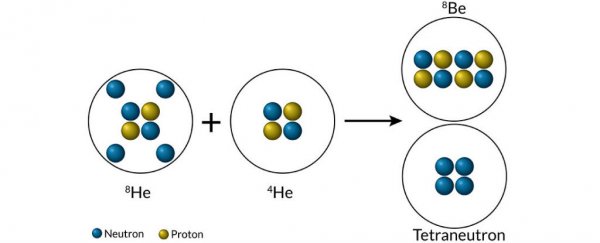Physicists have found the most convincing signs of a tetraneutron - a four neutron-no proton particle - to date, adding weight to the possibility that the hypothetical particle really does exist. According to theory, this highly elusive particle cluster is impossible, because of how unstable lone neutrons are, but scientists in Japan say they've spotted its signature during recent experiments.
While the results need to be replicated independently before we can truly say the fabled tetraneutron exists, if other teams can confirm its existence, we're going to have to make some serious changes to current understanding of nuclear forces. "It would be something of a sensation," nuclear theorist Peter Schuck from France's National Centre for Scientific Research, who wasn't involved in the discovery, told Science News.
Physicists have been searching for the tetraneutron for decades, and while this 1965 paper concluded that no evidence could be found and "the existence of tetraneutrons is most unlikely", four separate papers have since reported experimental observations of the particle.
Most recently, theoretical physicist Francisco-Miguel Marqués and his team at the Ganil accelerator in France used a new technique to observe the particle - by watching the disintegration of beryllium and lithium nuclei. In 2002, they were smashing beryllium-14 particles into carbon particles in an attempt to blow apart beryllium's cluster of four neutrons.
As Esther Inglis-Arkell explains over at Gizmodo, when they happened, they should have observed four little flashes, but instead, they got one big flash, signalling that these neutrons broke off in a cluster.
So why is the idea of four neutrons teaming up so impossible?
"Well, the Pauli exclusion principle specifies that particles in the same system cannot be in the same quantum state. As a consequence of this, even two neutrons shouldn't be able to stick together, let alone four," says Inglis-Arkell. "However, four neutrons smashing at high speed into a carbon atom, and then reaching a detector at exactly the same place and exactly the same time is nearly as impossible as the idea that a basic tenet of physics needs to be modified."
Marqués's team found similar evidence in 2004, but no one's been able to replicate their results, making true confirmation impossible… until now. A team from the University of Tokyo Graduate School of Science also worked with beryllium particles to produce what they're calling tetraneutron states.
They did this by firing a beam of helium nuclei (which have two protons and six neutrons) at liquid helium (which has two protons and two neutrons), and when the particles collided, four neutrons went missing. Their conspicuous absence lasted around 1 billionth of a trillionth of a second before reappearing as particle decay.
"Whenever a pair of alpha particles was detected from these second collisions, simple counting dictated that four neutrons must have been left behind - but were they bound to each other as a single particle, or had they simply flown off in separate directions as debris?" one of the team, Susumu Shimoura, said to Shern Ren Tee at Asian Scientist.
To confirm which was the more likely scenario, Shimoura and his team measured the energy given off by the particles in the reaction, and figured out that there wouldn't have been enough to propel each of the missing neutrons away independently. "This confirmed that the four neutrons left behind were indeed bound into a tetraneutron particle," Tee reports.
So what now? Separate teams of researchers are now needed to follow this team's methodology and come up with the same result and disprove any competing explanations for what they saw. If they can do that, theoretical physicists the world over are going to have to nut out more accurate guidelines for how we understand nuclear forces to behave.
And that's a really exciting thing. It's not every day that our fundamental understanding of the Universe has to be officially reestablished, and not only could we watch that happen, it could also lead to really important advances in our knowledge of how some of its most mysterious objects actually exist.
"Both very large atomic nuclei (where neutrons outnumber protons about three to two, on average) and neutron stars contain large clumps of neutrons, whose behaviour remains very poorly understood," says Shimoura.
The research has been published in Physical Review Letters.
